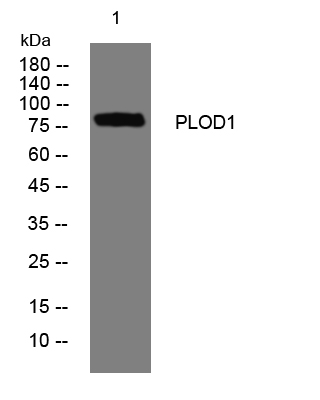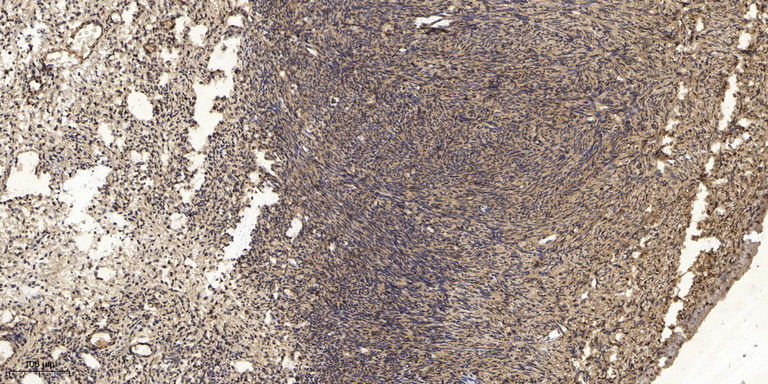PLOD1 rabbit pAb
- Catalog No.:YT7412
- Applications:WB;ELISA;IHC
- Reactivity:Human;Mouse;Rat
- Target:
- PLOD1
- Fields:
- >>Lysine degradation;>>Metabolic pathways
- Gene Name:
- PLOD1 LLH PLOD
- Protein Name:
- PLOD1
- Human Gene Id:
- 5351
- Human Swiss Prot No:
- Q02809
- Mouse Gene Id:
- 18822
- Mouse Swiss Prot No:
- Q9R0E2
- Rat Swiss Prot No:
- Q63321
- Immunogen:
- Synthesized peptide derived from human PLOD1 AA range: 551-601
- Specificity:
- This antibody detects endogenous levels of PLOD1 at Human/Mouse/Rat
- Formulation:
- Liquid in PBS containing 50% glycerol, 0.5% BSA and 0.02% sodium azide.
- Source:
- Polyclonal, Rabbit,IgG
- Dilution:
- WB 1:500-2000;IHC 1:50-300; ELISA 2000-20000
- Purification:
- The antibody was affinity-purified from rabbit antiserum by affinity-chromatography using epitope-specific immunogen.
- Concentration:
- 1 mg/ml
- Storage Stability:
- -15°C to -25°C/1 year(Do not lower than -25°C)
- Molecular Weight(Da):
- 80kD
- Background:
- Lysyl hydroxylase is a membrane-bound homodimeric protein localized to the cisternae of the endoplasmic reticulum. The enzyme (cofactors iron and ascorbate) catalyzes the hydroxylation of lysyl residues in collagen-like peptides. The resultant hydroxylysyl groups are attachment sites for carbohydrates in collagen and thus are critical for the stability of intermolecular crosslinks. Some patients with Ehlers-Danlos syndrome type VI have deficiencies in lysyl hydroxylase activity. Two transcript variants encoding different isoforms have been found for this gene. [provided by RefSeq, Oct 2015],
- Function:
- catalytic activity:Procollagen L-lysine + 2-oxoglutarate + O(2) = procollagen 5-hydroxy-L-lysine + succinate + CO(2).,cofactor:Ascorbate.,cofactor:Iron.,disease:Defects in PLOD1 are the cause of Ehlers-Danlos syndrome type 6 (EDS6) [MIM:225400]. EDS is a connective tissue disorder characterized by hyperextensible skin, atrophic cutaneous scars due to tissue fragility and joint hyperlaxity. EDS6 is characterized by the presence of ocular complications, particularly retinal detachment.,disease:Defects in PLOD1 are the cause of Nevo syndrome [MIM:601451]. This is a rare, autosomal recessive disorder characterized by increased perinatal length, kyphosis, muscular hypotonia, and joint laxity. Nevo syndrome and EDS-VI have similar clinical phenotypes. Some authors consider that both syndromes are the same clinical entity.,function:Forms hydroxylysine residues in -Xaa-Lys-Gly- sequences in coll
- Subcellular Location:
- Rough endoplasmic reticulum membrane; Peripheral membrane protein; Lumenal side.
- June 19-2018
- WESTERN IMMUNOBLOTTING PROTOCOL
- June 19-2018
- IMMUNOHISTOCHEMISTRY-PARAFFIN PROTOCOL
- June 19-2018
- IMMUNOFLUORESCENCE PROTOCOL
- September 08-2020
- FLOW-CYTOMEYRT-PROTOCOL
- May 20-2022
- Cell-Based ELISA│解您多样本WB检测之困扰
- July 13-2018
- CELL-BASED-ELISA-PROTOCOL-FOR-ACETYL-PROTEIN
- July 13-2018
- CELL-BASED-ELISA-PROTOCOL-FOR-PHOSPHO-PROTEIN
- July 13-2018
- Antibody-FAQs
- Products Images

- Western blot analysis of lysates from HEK293 cells, primary antibody was diluted at 1:1000, 4°over night

- Immunohistochemical analysis of paraffin-embedded human oophoroma. 1, Antibody was diluted at 1:200(4° overnight). 2, Tris-EDTA,pH9.0 was used for antigen retrieval. 3,Secondary antibody was diluted at 1:200(room temperature, 45min).



